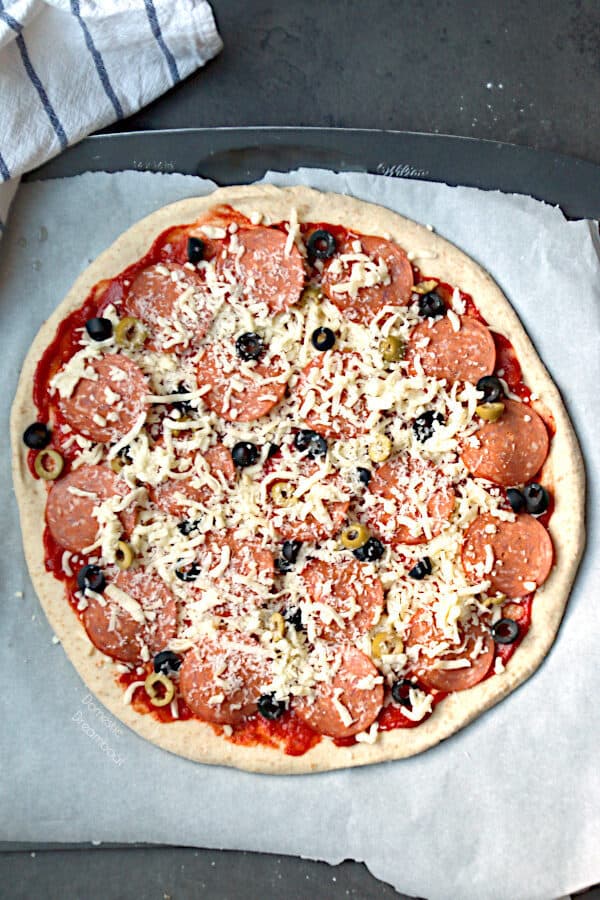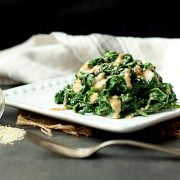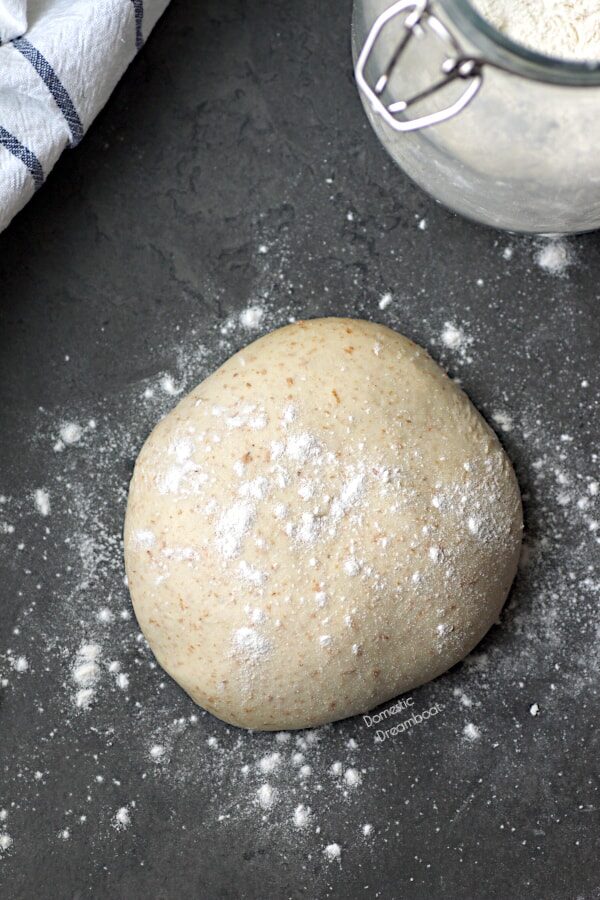Making homemade pizza is a fun and delicious meal, and a great way to get the whole family involved in cooking!
Do you ever make homemade pizza? I mean REAL homemade pizza - from scratch. Not frozen pizza that you just put in the oven.
If not, what are you waiting for? Homemade pizza was one best things to come out of the pandemic for my family. I made it before the pandemic occasionally, but being stuck at home and not being able to go to restaurants got me in the habit of making it regularly.
If you're interested in starting to make pizza from scratch, read on! I'll share all the things I've learned about making great homemade pizza over the past several months.

Why should I make homemade pizza?
I'll start off by saying that if you think you'll start making pizza from scratch because it's easier, or cheaper than buying pizza from a restaurant, you might want to re-think.
I don't make pizza at home because it's cheaper than store-bought (it's not), and I don't make it because it's easy (it's definitely not).
I make pizza from scratch at home because I enjoy it, and because it tastes great. My kids regularly tell me that pizza is their favorite thing that I cook, and that my pizza is the best pizza they've ever had.
However, homemade pizza is a bit of a labor of love that takes time, planning, and a few special tools. But to my family, the time we spend together making it, and eating it makes it totally worth it.

What equipment do I need to make homemade pizza?
The good news is that you can make delicious pizza right in your own oven. No need to buy a special wood-burning pizza oven!
But to make pizza as good as your local restaurant, you'll need a few items to help you cook and prepare it. You may even be able to repurpose some of the items you already have in your kitchen.

Food Processor
A good food processor is helpful, but not essential, to making great homemade pizza dough. If you don't already have a food processor, you can mix your dough with a stand mixer, or by hand.
Pizza Stone
If you only buy one thing to get you on your way to making homemade pizza, it should be a pizza stone.
Also known as a baking stone, a pizza stone is a large ceramic plate that you heat up in the oven, and cook your pizza on. This ensures that the pizza cooks from both below and above, creating crisp - not soggy - crust.
A pizza stone isn't just a single-purpose tool. You can also use one to make crusty, free-form loaves of bread.
If you're worried about where to store it, fear not. You can easily store your baking stone on the lowest oven rack at all times. It will even help to regulate your oven temperature no matter what you're cooking.
While I do, and always have used a ceramic pizza stone, alternatively, you can use a baking steel. A baking steel is just what it sounds like - a steel plate that you baking your pizza (or bread) on. It's more conductive, and less likely to break, but tends to be more expensive.
If you want to bake homemade pizza using something you already have, try an upside down metal baking sheet. Keep in mind that aluminum isn't as conductive as steel, and you might have to adjust the size of your pizza to make sure it fits.
Pizza Peel
A pizza peel is a flat wood board or metal plate with a handle. It's used to assemble your pizza before cooking, and to transfer it to and from your pizza stone in the oven.
While it certainly makes your pizza making job easier, a pizza peel might not be necessary if you already have something flat that works.
I've always used a rimless baking sheet, and have never felt the need to buy anything else. Bonus: you can also bake cookies on it.
Parchment Paper
Parchment paper can come in very handy when it comes to getting your uncooked pizza off of your pizza peel, and into the oven.
While you can do without it by sprinkling a generous amount of cornmeal on your pizza peel before laying your pizza dough on it, I find that the pizza comes out better with parchment. The cornmeal adds a gritty texture to the bottom of the pizza crust, and can burn easily.
Simply lay the parchment paper on the pizza peel and put the stretched dough on top (see detailed instructions to make dough). Then when the pizza is ready to cook, the pizza and parchment slide right onto the hot stone (you can later pull the parchment out from under the pizza to prevent burning).

What ingredients do I need to make homemade pizza?
When it comes to making pizza, there are a few basic ingredients: the dough, the sauce, the cheese, and the toppings. Keep reading to find out what you should keep on hand to make great pizza.
Pizza Dough
The dough (or crust) can make or break your pizza. My family loves my pizza because the crust is so good. Crisp on the bottom, but soft on the top. Does it take a long time and require lots of advance planning? Yes. Is it worth it? Also yes.
Pizza Sauce
Sure you could buy a can of pre-seasoned pizza sauce from the grocery store, but it's just as easy to quickly make your own and season it to taste. All you'll need is a can of tomato sauce, and add some garlic, herbs, and olive oil (see recipe below).
Cheese
There are a few options when it comes to cheese:
- Pre-shredded mozzarella or "pizza blend" cheese. No doubt, this is fast and easy, and it's what I typically reach for. The down-side is that most brands contain added starches to keep the shredded cheese from sticking together. It can cause the cheese to become gritty when it melts.
- Block cheese. It can be cheaper than pre-shredded, and it doesn't have any extra ingredients, but you will need to spend time and energy shredding it yourself.
- Fresh Mozzarella. This soft mozzarella typically comes in a log. Because it's so soft, it doesn't really shred, but can be thinly sliced and used on pizza. Because of it's high moisture content, some types can become watery on pizza.
In addition to mozzarella, you can use other cheeses to add more flavor. I usually add a little freshly shredded Parmesan on top of the other toppings right before baking. Feta is also a great option.
Toppings
The toppings of a pizza are where you can let your creativity shine. When I make pizza for my whole family, I usually go very traditional with pepperoni and olives. Somestimes I'll add a little cooked, crumbled Italian sausage.
But really, you can put anything you want on pizza from meat, to vegetables, to fruit, to herbs.
But there are a few pointers you'll want to keep in mind when it comes to adding toppings to make sure your pizza comes out of the oven perfectly:
- Avoid overly "wet" ingredients. If you're using something that was canned in water or juice (eg. pineapple or mushrooms), make sure you drain it very well and even dry any remaining moisture with a paper towel.
- Only use cooked meats. This includes ground meat or sausage, sliced steak or chicken, etc. If you wouldn't eat it raw, don't put it on pizza raw.
- Add delicate toppings after cooking. This might include leafy greens (eg. arugula) and fresh herbs (eg. basil or cilantro).
- Don't be too heavy handed with toppings and/or cheese. This can make it difficult to cook all the way through in the middle of the pizza. In general, use only a single thin layer of cheese, and a single thin layer of toppings.
Toppings over or under cheese? This is personal preference, and I don't think it really matters. If you like your toppings crispier, put them on top of the cheese. I usually put a very small amount of cheese under, and a very small amount of cheese on top of the toppings.
Want more pizza ideas?
Homemade Pizza Nutrition Notes:
Note that the nutrition information in the recipe below is for the sauce only, and includes the sauce that would be included in ½ of a medium pizza.
Most people don't exactly expect pizza to be healthy, but it can be considered a balanced meal if it's served with some veggies. The crust provides grain, and the cheese and any meaty toppings provide protein.
However, the cheese and some types of toppings (pepperoni, sausage, bacon, etc.) are typically high in saturated fat and sodium. Eat in moderation.

Super Easy Pizza Sauce
Ingredients
- 14 oz canned tomato sauce
- 1 Tablespoon olive oil
- 1 clove garlic minced
- 1 teaspoon dried basil
- ½ teaspoon dried oregano
- 1 pinch red pepper flakes (optional)
Instructions
- Stir together 14 oz canned tomato sauce, 1 Tablespoon olive oil, 1 clove garlic, 1 teaspoon dried basil, ½ teaspoon dried oregano, and 1 pinch red pepper flakes in a medium bowl. Set aside until ready to use. Can be refrigerated in an airtight container for up to a week.





















Leave a Reply